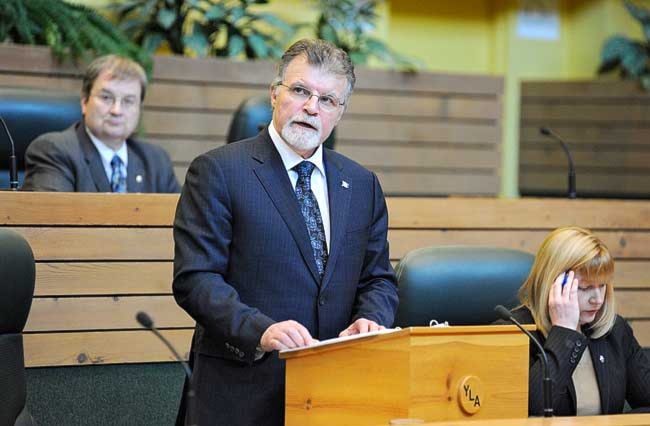Federal budgets, by their very nature, are mixed bags. Regions and interest groups lobby for their causes and win, lose or draw as fortune and politics dictate.
Rarely will anyone walk away wholly pleased, apart from members of the governing caucus who are dispatched with talking points and the promise of political self-immolation should they step out of line.
So it was with Budget 2017, notable for very little except a 30-minute delay caused by Opposition MPs filibustering over the Liberal government’s proposed changes to parliamentary procedure, and for drawing back some from last year’s hard-spending attempt at economic stimulus.
The North is both a region and an interest group, owing to the territories’ unique status within Confederation and to their near-total financial dependence on Ottawa. Justin Trudeau’s government has not bestowed the same brand-building status on the North that Stephen Harper did. But where Harper preferred to mostly tinker at the edges of the North’s systemic issues come budget time, Trudeau’s government has been far more willing to spend.
Three major line items are of particular note, including $300 million for housing in the territories. Two-thirds of that goes to Nunavut, which is in a perpetual housing emergency. The Yukon gets $24 million, which won’t solve all our problems.
On energy, there’s a $400-million Arctic Energy Fund for the “renewal and replacement of energy systems in northern communities, so that remote communities can reduce their reliance on diesel.” This fund is on top of an existing program to phase out diesel generation in the North. But it doesn’t start until 2018 and the funding is spread out over 10 years. Moreover, how will this fund work? The budget contains no details. And considering the desperate condition of power systems in both the N.W.T. and Nunavut, it’s difficult to foresee how much of this money will ever be available to the Yukon.
Then there’s $2 billion over 11 years for Northern and rural infrastructure. The presence of the word “billion” and decade-plus timeframe might give the illusion of a visionary initiative, but is pretty thin gruel once spread out across the entire North. As Peter Turner of the Yukon Chamber of Commerce told the CBC, “the North is sort of a rounding error” for the federal government.
That new infrastructure money does, however, follow one of the recommendations of a report on Northern infrastructure issued by the Federation of Canadian Municipalities: it will be calculated on a base-plus-per-capita basis, instead of a per capita formula that would fleece the sparsely populated territories.
Meanwhile, the Yukon Party notes that this year’s budget does not restore some $32 million in reductions over five years to territorial formula financing, the block grant that funds YG’s day-to-day operations. The Yukon Party calls it a cut, while the federal Liberals said it was a recalculation based on census figures. Whichever party you like best is right.
The Yukon Party compliments the housing money, as well as the $25.6 million Yukon will get over four years from the Territorial Health Investment Fund. But it also criticizes the federal Liberals for their territorial counterparts’ forthcoming deficit, even though Yukon’s deficit is in no way the federal government’s problem, and even though a single year’s deficit is not a serious problem at all. (Systemic deficits that run up debt are a problem, and should the Yukon Liberals go down that road, the YP will be right to make hay about it.)
Over its first two budgets, the Trudeau government has attempted what the Harper governments were never willing to do: pony up cash for the real infrastructure shortages that the territories can’t tackle on their own. This is progress, but you might also argue it isn’t enough. Nunavut, for instance, got less than half of the $425 million it requested for housing, which is roughly a third of what it says it needs to solve its housing crisis. In other words, it’s never enough.
But the other question is whether all this spending is sustainable. Again, individual deficits are harmless, and, in the case of the 2008 recession, probably desirable. And too much debt is bad, because it costs money to service. What really matters is the amount of debt relative to the size of the economy. Canada’s debt-to-GDP ratio is around 31 per cent — Germany’s is 78 per cent and Greece, which is screwed, has a ratio of 175 per cent.
But people tend to freak out about debts, because practical concerns about indebtedness tend to get amplified by religious views of debt as sin (and also by the Canadian Taxpayers Federation). Voters see Canada’s national debt standing at $636 billion and think the repo man is about to kick down the door. This is not exactly how sovereign debt works, but it doesn’t matter. A large portion of the electorate hates government and has religious issues about indebtedness. Austerity is perpetually around the corner.
The (Liberal) austerity budgets of the mid-1990s are not remembered fondly in the North. Justin Trudeau’s stimulus budgets have a lot of badly needed cash for the territories. But he’s walking a very fine line. There’s still no timeline for Canada to return to balanced budgets and the longer that lasts, the greater the likelihood is of a sharp turn back to austerity.
There’s a great deal of uncertainty here. Trudeau’s gambit may or may not pay off. If his government fails, the North has more to lose than most.
Contact Chris Windeyer at editor@yukon-news.com
